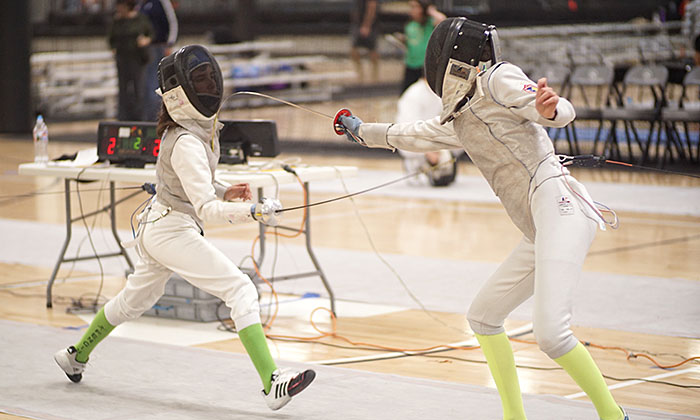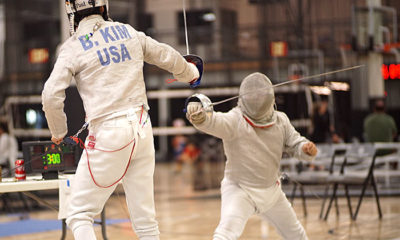
Colette Shvager (right, UFA) scores with a counter-attack against Julie Gaeta (Precision) in the Y14 Women’s Foil event at the 2017 SoCal Division Summer Nationals Qualifiers in Thousand Oaks.
Promotion
In Y10, Y12, and Y14, all fencers in all tournaments, regardless of how well they did in pools, move on, or are promoted to the Direct Elimination round. In Cadet and Junior national and international events, the bottom 20% of fencers out of pools are eliminated and do not move on to the next round.
Direct Elimination Seeding
Direct Elimination placement is based on the results of the pool bouts. The number one seeded fencer out of pools would be the fencer who won the highest percentage of his pool bouts with the highest number of indicator points. He would be ranked number one, and at the very top of the tableau. (Tableau is the break down of the elimination round. Each round in the tableau is called a table. The rounds are tables of: 512 / 256 / 128 / 64 / 32 / 16 / 8 / 4 / 2. ) The fencer seeded number two out of pools would be at the very bottom of the tableau.
Starting with the smaller, local tournament, using the example from the Pools blog, there were 13 fencers, so looking at the tableau, it starts at table of 16 (16 slots), with three fencers getting a bye to the next round. Take a look:

Because this tournament is finished, you can see the score of each bout. The first score is always the top name, the second score, the bottom name. So, in the final, Tommy Wells beat Stafford Moosekian, and the score was Tommy 15- Stafford 13.
Now let’s go on to the more complicated Cadet event from the same blog.
Because this event was a national event, 20% of the fencers were eliminated, so only the top 130 advanced to the Direct Eliminations. The 130 fencers are then divided into pods, based on seeding. Only 2 fencers, who placed 127, 128, 129, and 130, did not receive a bye into the next level – 128.
Typically, the fencer who is seeded second out of pools is at the very bottom of the tableau, the idea being that the top two fencers eventually meet each other in the final round.
Here is the top section of the Direct Elimination round:

The tableau is made of up all the fencers divided into groups of fencers called pods. Fencers will first face fencers within their pod. If your fencer wins the pod, he or she will next face the winner from another pod. In this event, there were 4 pods, and each pod consisted of 33 fencers. (The photo above shows only a part of the pod.) The quarter finals or the semi finals, depending on the size of the tournament, will be the top fencers from each pod facing another. So pod 1 faces pod 2, and pod 3 faces pod 4, etc.
Each Direct Elimination bout goes to 15 touches, with three periods that last three minutes each. There is a one minute break between each period, so two breaks per bout. ( Y10 events only go to 10 touches.) The bout ends when either a fencer reaches 15 touches, or the time runs out. In the event of a tie at the end of the final period, there is a one minute extended period, during which either fencer can score a final touch. In this situation, double touches do not count. At the beginning of this extended period, there is an electronic coin toss – a random mechanical assignment of “priority” which means that if neither fencer scores a touch, the fencer who was awarded “priority” wins.
During the one minute rest, fencers often get a quick visit from the coach and a chance to get a drink. Fencers should bring a bottle of water, gatorade, etc., to the strip or have someone stripside with something, as fencers are not allowed to leave the strip until the bout is over.
Fencers should salute the opponent and referee at the beginning and end of each period.
This blog is about Direct Eliminations and how they work. However, there are a lot of rules that fencers need to be aware of, as well as a code of conduct on the strip that must be followed. Sometimes a fencer might want to question a ref’s call which is fine, but it should be done respectfully. Fencing rules can be found in the rules handbook, and with experience, fencers will learn what they are, remember them, and in some cases, use them to gain advantage.
Happy fencing!
Addendum
This very useful information for determining a fencer’s Direct Elimination opponent was provide to us by Fencing Dad. Thanks, Fencing Dad!
Great article! For the impatient fencers: Kids often want to know who they are going to fence when the seedings come out after the pools (but before the tableau is posted). The formula is the following: Table (minus) your Seed (plus) one. So, if there are 17 fencers and you are seeded 16th after pools, here is the calculation: 32 (table) – 16 (your seed) + 1 = 17 (your opponent). So, you fence the 17th seed. (The winner of that match means you are in the next table — so, 16 (table) – 16 (winner of the match takes the better seeded seat) + 1 = 1 (thus, the winner of 16th vs 17th will fence the 1st seed). Another example: If you are seeded 15th after pools, it is 32 – 15 + 1 = 18 (since no one is 18th seed, you have no one to fence, so you get a bye; then go down to the next table: 16 (next table) – 15 + 1 = 2 — so, you will fence the 2nd seed.















Fencing Dad
2018-05-21 at 11:26 AM
Great article! For the impatient fencers: Kids often want to know who they are going to fence when the seedings come out after the pools (but before the tableau is posted). The formula is the following: Table (minus) your Seed (plus) one. So, if there are 17 fencers and you are seeded 16th after pools, here is the calculation: 32 (table) – 16 (your seed) + 1 = 17 (your opponent). So, you fence the 17th seed. (The winner of that match means you are in the next table — so, 16 (table) – 16 (winner of the match takes the better seeded seat) + 1 = 1 (thus, the winner of 16th vs17th will fence the 1st seed). Another example: If you are seeded 15th after pools, it is 32 – 15 + 1 = 18 (since no one is 18th seed, you have no one to fence, so you get a bye; then go down to the next table: 16 (next table) – 15 + 1 = 2 — so, you will fence the 2nd seed.